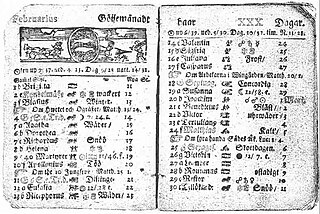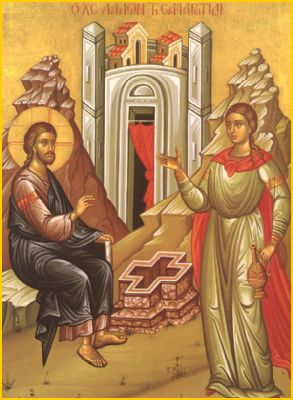Related Research Articles

Easter, also called Pascha or Resurrection Sunday, is a Christian festival and cultural holiday commemorating the resurrection of Jesus from the dead, described in the New Testament as having occurred on the third day of his burial following his crucifixion by the Romans at Calvary c. 30 AD. It is the culmination of the Passion of Jesus Christ, preceded by Lent, a 40-day period of fasting, prayer, and penance.
A moveable feast is an observance in a Christian liturgical calendar which occurs on different dates in different years.
The Revised Julian calendar, or less formally the new calendar and also known as the Milanković calendar, is a calendar proposed in 1923 by the Serbian scientist Milutin Milanković as a more accurate alternative to both Julian and Gregorian calendars. At the time, the Julian calendar was still in use by all of the Eastern Orthodox Churches and affiliated nations, while the Catholic and Protestant nations were using the Gregorian calendar. Thus, Milanković's aim was to discontinue the divergence between the naming of dates in Eastern and Western churches and nations. It was intended to replace the Julian calendar in Eastern Orthodox Churches and nations. From 1 March 1600 through 28 February 2800, the Revised Julian calendar aligns its dates with the Gregorian calendar, which had been proclaimed in 1582 by Pope Gregory XIII.
Reform of the date of Easter refers to proposals to change the date for the annual celebration of Easter. These proposals include setting a fixed date or agreeing between Eastern and Western Christendom a common basis for calculating the date of Easter so that all Christians celebrate the Festival on the same day. As of 2023, no such agreement has been reached.

As a moveable feast, the date of Easter is determined in each year through a calculation known as computus. Easter is celebrated on the first Sunday after the Paschal full moon, which is the first full moon on or after 21 March. Determining this date in advance requires a correlation between the lunar months and the solar year, while also accounting for the month, date, and weekday of the Julian or Gregorian calendar. The complexity of the algorithm arises because of the desire to associate the date of Easter with the date of the Jewish feast of Passover which, Christians believe, is when Jesus was crucified.

The Swedish calendar or Swedish style was a calendar in use in Sweden and its possessions from 1 March 1700 until 30 February 1712. It was one day ahead of the Julian calendar and ten days behind the Gregorian calendar. Easter was calculated astronomically, with a minor exception, from 1740 to 1844.

Spring, also known as springtime, is one of the four temperate seasons, succeeding winter and preceding summer. There are various technical definitions of spring, but local usage of the term varies according to local climate, cultures and customs. When it is spring in the Northern Hemisphere, it is autumn in the Southern Hemisphere and vice versa. At the spring equinox, days and nights are approximately twelve hours long, with daytime length increasing and nighttime length decreasing as the season progresses until the Summer Solstice in June and December.

The Paschal Triduum or Easter Triduum, Holy Triduum, or the Three Days, is the period of three days that begins with the liturgy on the evening of Maundy Thursday, reaches its high point in the Easter Vigil, and closes with evening prayer on Easter Sunday. It is a moveable observance recalling the Passion, Crucifixion, Death, burial, and Resurrection of Jesus, as portrayed in the canonical Gospels.
Quartodecimanism is the name given to the practice of celebrating the death of Christ on the day of Passover on the 14th of Nisan according to the biblical dating, being on whatever day of the week. The Quartodeciman controversy in the Church was over the question of celebrating Easter on the first day of the week, Sunday, or Passover at the same time as the sacrifice of the Passover lamb.

A golden number is a number assigned to each year in sequence which is used to indicate the dates of all the calendric new moons for each year in a 19-year Metonic cycle. They are used in computus and also in Runic calendars. The golden number of any Julian or Gregorian calendar year can be calculated by dividing the year by 19, taking the remainder, and adding 1.
The Eastern Orthodox liturgical calendar describes and dictates the rhythm of the life of the Eastern Orthodox Church. Passages of Holy Scripture, saints and events for commemoration are associated with each date, as are many times special rules for fasting or feasting that correspond to the day of the week or time of year in relationship to the major feast days.

The March equinox or northward equinox is the equinox on the Earth when the subsolar point appears to leave the Southern Hemisphere and cross the celestial equator, heading northward as seen from Earth. The March equinox is known as the vernal equinox in the Northern Hemisphere and as the autumnal equinox in the Southern Hemisphere.
The controversy over the correct date for Easter began in Early Christianity as early as the 2nd century AD. Discussion and disagreement over the best method of computing the date of Easter Sunday has been ongoing ever since and remains unresolved. Different Christian denominations continue to celebrate Easter on different dates, with Eastern and Western Christian churches being a notable example.
Fasika (Ge'ez: ፋሲካ, sometimes transcribed as Fasica; [ultimately from Aramaic פַּסְחָא ] is the Ge'ez, Amharic, and Tigrinya word for Easter, also called Tensae.

The Pentecostarion is the liturgical book used by the Eastern Orthodox and Byzantine Catholic churches during the Paschal Season which extends from Pascha (Easter) to the Sunday following All Saints Sunday.
The Sardica paschal table or Sardica document is a document from a Latin manuscript of the 7th/8th century AD. It is a copy in Latin translation of the creed of the Eastern Christian bishops attending the Council of Sardica who, fearing that their deliberations would be dominated by Western bishops, met separately at Philippopolis. Appended to the creed and anathemas is a table of Paschal full moon dates, given as dates in the Julian calendar, for the years 328 to 357, together with a list of dates of 14 Nisan in the Jewish calendar, also referred to the Julian calendar, for the years 328 to 343, the year of the Council. The calendrical information contained in the document has been used by scholars in tracing the history of the computus and of the Hebrew calendar.
An ecclesiastical full moon is formally the 14th day of the ecclesiastical lunar month in an ecclesiastical lunar calendar. The ecclesiastical lunar calendar spans the year with lunar months of 30 and 29 days which are intended to approximate the observed phases of the Moon. Since a true synodic month has a length that can vary from about 29.27 to 29.83 days, the moment of astronomical opposition tends to be roughly 14.75 days after the previous conjunction of the Sun and Moon. The ecclesiastical full moons of the Gregorian lunar calendar tend to agree with the dates of astronomical opposition, referred to a day beginning at midnight at 0 degrees longitude, to within a day or so. However, the astronomical opposition happens at a single moment for the entire Earth: The hour and day at which the opposition is measured as having taken place will vary with longitude. In the ecclesiastical calendar, the 14th day of the lunar month, reckoned in local time, is considered the day of the full moon at each longitude.
Paschal is a surname and given name.

A computus clock is a clock equipped with a mechanism that automatically calculates and displays, or helps determine, the date of Easter. A computus watch carries out the same function.
References
- ↑ Bien, Reinhold (July 2004). "Gauß and Beyond: The Making of Easter Algorithms" . Archive for History of Exact Sciences. 58 (5): 439–452. Bibcode:2004AHES...58..439B. doi:10.1007/s00407-004-0078-5. ISSN 0003-9519. JSTOR 41134247. S2CID 121657716.
- ↑ World Council of Churches / Middle East Council of Churches Consultation (1997-03-10). "Towards a Common Date of Easter". World Council of Churches . Aleppo. Archived from the original on 2021-12-17. Retrieved 2022-03-18.
- ↑ Marcus, Imanuel (2021-03-22) [2019-03-20]. "Western and Eastern Easter: Different Dates for the Same Holiday". Berlin Spectator. Berlin. Archived from the original on 2021-11-18. Retrieved 2022-03-18.
- 1 2 3 4 5 6 "Moonwise: New Easter Dates". Moonwise. Archived from the original on 2022-01-28. Retrieved 2022-03-18.
- ↑ "The Christian Calendar - Easter". WebExhibits . Archived from the original on 2021-05-11. Retrieved 2022-03-18.
- ↑ van Gent, R. H. (Rob) (January 2022). "Perpetual Easter and Passover Calculator". Mathematical Institute, Utrecht University . Utrecht. Archived from the original on 2022-02-05. Retrieved 2022-03-18.
- ↑ Francis, Richard L. (Spring 1992). "The Easter Date Pattern" . Pi Mu Epsilon Journal. Pi Mu Epsilon. 9 (6): 374–383. ISSN 0031-952X. JSTOR 24340245.
- ↑ "Moon Phases 2000 – Lunar Calendar for Jerusalem, Israel". Time and Date. Archived from the original on 2017-03-28. Retrieved 2022-03-18.
- ↑ "Solstices & Equinoxes for Jerusalem (2000—2049)". Time and Date. Archived from the original on 2021-01-22. Retrieved 2022-03-18.
- ↑ Edward M. Reingold and Nachum Dershowitz. "Calendrical Calculations. Appendix C: Sample Data" (PDF). Retrieved 2023-11-15.
- ↑ Tighe, William J. (2010-03-24) [2003]. Peck, John (ed.). "Passover to Pascha". Preachers Institute. Archived from the original on 2020-09-23. Retrieved 2022-03-18.
- ↑ Damick, Andrew Stephen (2015-03-31). "No, Pascha does not have to be after Passover (and other Orthodox urban legends)". Ancient Faith Ministries . Archived from the original on 2021-11-16. Retrieved 2022-03-18.
- ↑ Fotopoulos, John (2017-04-02) [2016]. "Some Common Misperceptions about the Date of Pascha/Easter". Public Orthodoxy. New York City: Orthodox Christian Studies Center, Fordham University. Archived from the original on 2021-06-28. Retrieved 2022-03-18.
- ↑ "Towards a Common Date for Easter". Aleppo, Syria: World Council of Churches (WCC) / Middle East Council of Churches Consultation (MECC). 1997-03-10.
- ↑ North American Orthodox-Catholic Theological Consultation (2010-10-01). "Celebrating Easter/Pascha Together". United States Conference of Catholic Bishops . Washington, D.C. Archived from the original on 2021-05-08. Retrieved 2022-03-18.
- ↑ North American Orthodox-Catholic Theological Consultation (1998-10-31). "Common Response to the Aleppo Statement on the Date of Easter/Pascha". Assembly of Canonical Orthodox Bishops of the United States of America . Washington, D.C. Archived from the original on 2022-03-18. Retrieved 2022-03-18.
- ↑ Lutheran-Orthodox Dialogue in the U.S.A. (1999-07-13). "Common Response to the Aleppo Statement On the Date of Easter/Pascha" (PDF). Evangelical Lutheran Church of America . Ligonier, Pennsylvania. Archived (PDF) from the original on 2022-01-24.
- ↑ "Catholiques et orthodoxes à la recherche d'une date commune pour Pâques". Actualités (in French). Society of Saint Pius X. 2021-03-25. Archived from the original on 2022-03-18. Retrieved 2022-03-18.